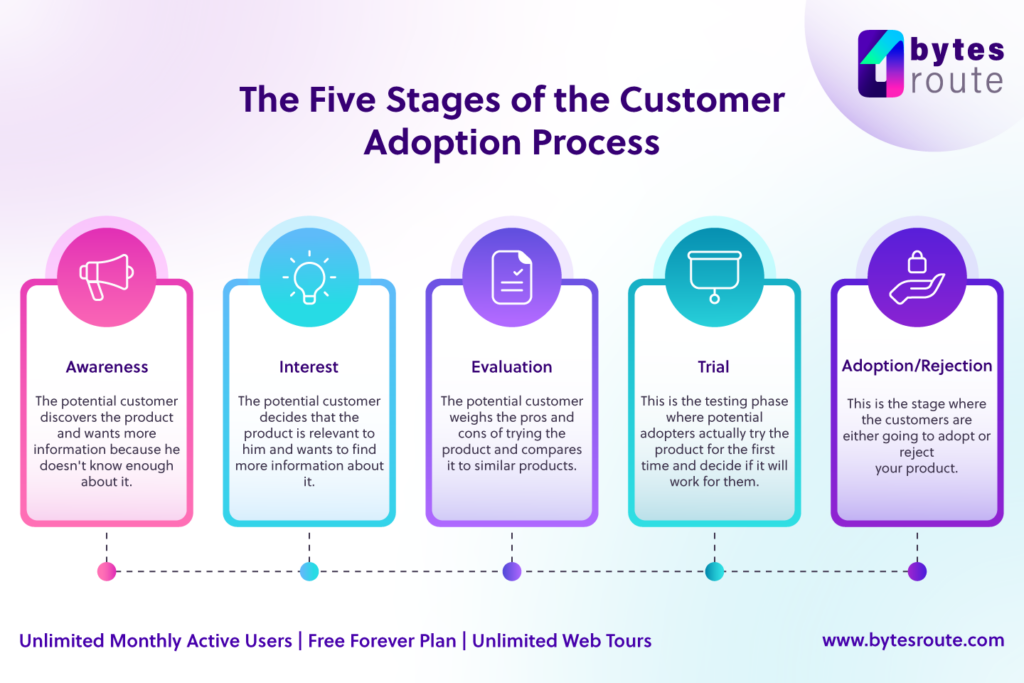Product Adoption
What is Product Adoption?
Definition:
“Product Adoption” refers to the process by which users become aware of, understand, and start actively using a new product or service. It involves a strategic approach to introducing and integrating a product into the market, ensuring that users not only purchase the product but also derive value from its features and functionalities. Successful product adoption goes beyond the initial sale, focusing on creating a positive user experience, providing necessary support, and fostering long-term engagement.
Analogy:
Think of product adoption as the introduction of a new gadget to the market. Just as the success of the gadget depends on how well it is received, understood, and integrated into users’ lives, product adoption involves creating a seamless and positive experience to encourage users to embrace and utilize the product effectively.
Further Description:
Product adoption encompasses various stages and considerations:
Launch Strategy: Develop a comprehensive plan for introducing the product to the market. This includes defining target audiences, creating marketing materials, and selecting appropriate channels for promotion.
User Onboarding: Design a user-friendly onboarding process to guide users through the initial steps of using the product. This may involve tutorials, tooltips, and interactive features to familiarize users with key functionalities.
Educational Resources: Provide users with resources such as user manuals, FAQs, and online tutorials to help them understand the product’s features and capabilities. Clear and accessible information contributes to a smoother adoption process.
Customer Support: Offer responsive customer support to address user inquiries and issues promptly. Effective support builds trust and confidence, crucial for ongoing product adoption.
Feedback Mechanism: Establish a feedback loop to gather insights from users. This information helps identify areas for improvement, new feature requests, and overall user satisfaction.
Engagement Strategies: Implement strategies to keep users engaged with the product over time. This may involve regular updates, promotions, loyalty programs, and community building.
Metrics and Analytics: Define key performance indicators (KPIs) to measure product adoption success. Metrics may include user activation rates, user retention, and the frequency of product use.
Why is Product Adoption Important?
Maximizing Value: Successful product adoption ensures that users derive maximum value from the product, leading to customer satisfaction and loyalty.
Market Competitiveness: Products that are well-adopted in the market gain a competitive edge. Positive user experiences and strong adoption rates contribute to a product’s market position.
Customer Retention: Focusing on product adoption contributes to long-term customer retention. Satisfied and engaged customers are more likely to continue using a product and become advocates.
Brand Reputation: Positive product adoption experiences contribute to a positive brand reputation. Users are more likely to recommend a product they find easy to use and valuable.
Iterative Improvement: Continuous monitoring of product adoption allows for iterative improvement. Understanding user behavior and preferences helps in refining the product for enhanced user satisfaction.
Examples and Usage:
Apple iPhone Launches: Apple’s iPhone launches are notable examples of successful product adoption. Through effective marketing, user-friendly interfaces, and a strong ecosystem, Apple ensures that users quickly adopt and integrate new iPhone models into their lives.
Slack: Slack, a communication and collaboration tool, achieved widespread product adoption by offering a user-friendly interface, seamless onboarding, and regular updates. It became a staple for team communication in many organizations.
Netflix: Netflix continuously focuses on product adoption by providing personalized recommendations, an intuitive user interface, and a vast library of content. This approach ensures that subscribers actively use and enjoy the streaming service.
Key Takeaways:
- Plan a comprehensive launch strategy to introduce the product effectively to the target market.
- Design an onboarding process that is intuitive and guides users through the initial steps of using the product.
- Provide clear and accessible resources to help users understand the product’s features and functionalities.
- Offer timely and responsive customer support to address user inquiries and issues.
- Establish a feedback mechanism to gather insights from users, contributing to continuous improvement.
- Implement ongoing strategies to keep users engaged with the product over time.
- Define key performance indicators to measure product adoption success and track user behavior.





